Learning to Route Develop and Big Wall Climb in Spitzkoppe, Namibia Preparatory Ramblings
Preparatory Ramblings
It has taken me some time to submit this report. On my return from Namibia, I was greeted by a series of emergencies that overtook my capacity to reflect on my experiences in Spitzkoppe. More importantly, I was struggling with how to narratively conceptualize what had, to my surprise, turned into an emotionally harrowing, impactful, and growth-filled trip.
As outdoor recreators and athletes, we are inundated with the familiar narrative equation of goal plus setback(s), fortitude, and skill equals success or failure. It is a natural structure for athletic endeavors and big projects. Still, it didn’t feel like it captured the complexity of my experience in Namibia.
The question of how to tell “adventure stories” outside of that framework has been on my mind for some time. As someone whose research is encased in storytelling, and centers the relationships between our bodies and land, it is unsurprising that I have overthought the ultimately simple task of writing a trip report. I have tried to tell you the whole story, and, despite my best efforts, I appear to have fallen into that framework as well.
The last thing I want to mention before beginning is the tragic death of Alex Tarr. Alex was the younger brother of my sister-in-law, Bronwyn Tarr. He died just a few weeks before my departure. He was 33 and leaves behind his wife and little boy. This had, and continues to have, a massive impact on Bronwyn and our family. Peter and Jacquie Tarr are Bronwyn and Alex’s parents. In the midst of their grief, they were gracious enough to open their home to me. I am so very grateful for their support and the chance this trip gave me to spend time getting to know my new extended family.
Windhoek
As the plane shuddered to a stop, I saw rolling hills of arid brushland, yellow grass with unfamiliar mopane and acacia trees punctuating the landscape (Figure 1). After two trans-continental flights and thirty-some hours of travel, I should have been blurry-eyed as flight LH4356 touched down in Windhoek, Namibia’s capital. Instead, I felt excited with just a touch of apprehension about the unknown experiences ahead of me.
I don’t remember when the idea arose, but I do remember my brother, Cole Robertson, and I were walking through the Smoke Bluffs. “You should come with me to Nam,” he had said. After months of planning, and with the invaluable support of the VOC and the Neil Mackenzie Adventure Grant, I had arrived. I was meeting Cole, Bronwyn, and their brand-new baby Lyra, at Peter and Jacquie’s home. The plan was to spend a few days in the sleepy capital, before heading (circuitously) to Spitzkoppe inselberg where Cole and I would stay (Figure 2).
Figure 1 Photo of the arid Namibian bushveld, taken close to Peter and Jacquie’s home (film). Bushveld is an Africans term used to describe this type of arid plain.
Figure 2 This picture of the Spitzkoppe inselberg is taken roughly 1.5 kilometers away from the southwest face. Scale becomes very challenging to estimate in this geography, but if you look closely, two tourists and a truck are visible as references in the central frame.
A striking red-granite batholith, the Spitzkoppe formation rises some 1750 meters above the arid bushveldt and ephemeral rivers of the Namib desert (Figure 4). Its southwest wall hosts the preponderance of Namibia’s difficult climbing and boasts routes of 300–400 meters ranging from 5.10 to 5.13. We intended to develop a new route on the southwest face (Figure 3). Cole had scouted the line on two previous trips while developing Slabchip (12a, 400m) on the same wall. Most of the obvious features had been climbed, but dropping like a falling stone from a water runnel in the upper slabs is a streak of white. The water-washed granite splits the main wall in half. This was our objective.
Cole picked me up from the airport, and, as we drove through the winding roads, we began to talk plans. While Cole was motivated by the route itself, my goals centered on learning. This would be my first time developing, and my first big wall experience. I was excited to absorb as much knowledge as I could from the project. Retrospectively, I was naïvely optimistic about the difficulties ahead of me.

Figure 3 Southwest face of Spitzkoppe and our proposed topo, including Cole’s original route, Slabchip.
Figure 4 The ephemeral rivers of the Namib desert, as seen from halfway up The White Streak. Although they are called rivers, the waterways only flood every year or two. Despite this, they support a unique ecosystem with trees whose deep routes tap the remnants of flood water long after the surface has dried. Because of this, the rivers are much greener, with larger vegetation than the surrounding desert. This makes them visible from above, and a key source of life in the Namib.
Kindly, the Tarrs were lending us their truck and much of their camping gear. Cole had done the preponderance of preparation the preceding month; cooking and freezing meals and gathering supplies. In addition to what we had each flown with, Cole had left some food, climbing, and development gear with Peter and Jacquie in 2018.
The first few days in Windhoek passed quickly. Cole and I organized gear (Figure 5) and searched Windhoek’s malls and hardware stores for a fanny pack (so I could carry bolts, snacks, and extra drill bits,) and a second torque wrench, which is used to ensure nuts are tightened to 35 kilonewtons. You can also assess this by listening for a clear tone when the bolt is hit with a hammer). I spent the rest of my time catching up with Bronwyn and getting to know Peter, Jacquie, and Lyra.
Figure 5 Lyra “helping” us pack (top, film). A dry run of the portaledge setup (bottom). Cole trying to make the ever-finicky InReach work amongst the piles (middle).
Peter and Jacquie welcomed me into their rural home with astounding hospitality despite their heartbreak. Their love for ecology is palpable, as is their expertise in local flora and fauna. Professionally, Peter’s career as a government environmentalist allowed him to contribute a great deal to Namibia’s progressive environmental policies and species conservation. Jacquie’s expertise stems from her scientific training, teaching career, and art practice. Their knowledge is also embodied — developed from years spent on the land. For me, learning from them and being in a foreign ecology was one of the most beautiful aspects of this trip. I found myself in awe of the bushveldt and the desert, constantly curious about the many new plants and animals I encountered. I continue to be grateful to Peter and Jacquie for sharing their love and expertise, binoculars and identification books with me, for pointing out black eagles and baboons, explaining the habits of local ungulates (kudo, eland, springbok, and wildebeest), and for answering my endless questions. They were patient as I tried to learn all the new names and relationships between endemic species. Most of all, I am grateful they opened their home to me in such a vulnerable time.
Waterberg + Etosha
Cole, Bronwyn, Lyra, and I rolled out on a Saturday. Jacquie packed us sandwiches for the trip and we waved goodbye while Peter marshaled the dogs. The little truck was so laden down with gear that we could barely see out the windows. As we drove north along the B1, heat rose in shimmering waves off the pavement. Between infrequent wails from Lyra, we talked about the colonial history of Namibia and its present-day ramifications.
Eventually, we turned onto a dirt road. The landscape was significantly greener; the towering termite hills and bleached grass had given way to dense brush. Then, way off in the distance, the red sandstone plateau of Waterberg National Park became visible (Figure 6).
Figure 6 A view of the plateau (left). A view from the top, taken after hiking up on our second day (right). It is hard to capture the eerie magnitude of this geological feature. The cliffs offer almost endless opportunities for single-pitch trad climbing. Seemingly out of nowhere, red sandstone rises out of the Kalahari Plains which stretch all the way to Angola.
We spent two nights in a little park cabin. A friend and local developer, Richard Ford, had put up a few lines in Waterberg and we wanted to do some reconnaissance for future development. We hiked the lush trails and bushwhacked along the base of the cliffs (Figure 7). The rock was beautiful, if somewhat broken. Covered in bright lichens, it was reminiscent of Jackson Pollock’s expressionist paintings (Figure 8). Although there was extensive development potential, Bronwyn, Cole and I felt hesitant about disturbing the lush ecosystem. After chatting with a local guide, we nixed the idea altogether. He informed us that Black Rhino poaching was a big issue in the area and that any increase in traffic or access would put the animals at greater risk.
Figure 7 Me, looking up at one of the many potential single-pitch 5.10 crack climbs along the Waterberg Plateau (left). Close up of the face (right).
Figure 8 Lichens at Waterberg National Park.
As we left Waterberg, we came across a herd of sixteen giraffes along the side of a backroad. They watched us with huge and curious eyes, while contemplatively browsing twigs and leaves off the trees. Lyra and I were enthralled by their giant bodies and calm presence. One particularly cautious cow hid her torso behind some mopane, forgetting we could see her sprawling limbs and neck, while the bull watched us from the middle of the road (Figure 9).
Figure 9 Bull giraffe watching over his herd just outside Waterberg National Park.
After Waterberg, we drove north to spend three days exploring Etosha National Park. Etosha is a wildlife conservation and research area along the southern rim of a massive salt pan (famously visible from space). It was a delightful fiasco replete with diaper explosions, and nap-time hangboarding sessions, as well as some incredible animal sightings, and truly absurd off-the-cuff songs (Figure 10).
Figure 10 Zebras, just chilling out (top left, film). Cole sneaks in a quick finger session while Lyra naps (bottom left). Bronwyn and Lyra, just minutes before the great poop fiasco (right).
Spitzkoppe – Development
On the evening of May 11th, we arrived in Spitzkoppe just as dusk was rolling in (Figure 11). We were all tired from the long drive, but Cole and Bronwyn’s excitement was palpable. Stories from their previous two trips spilled from them in excited gushes. We stopped the truck next to the park gates and went inside the small office, looking for our contact, Juandre. Spitzkoppe is operated by the Damara Community Development Association; through camping, climbing, hiking, and guiding fees, revenue is funneled from tourists directly into the local community. After chatting with Juandre, and inquiring about our friend Benny, we left a freezer box at the rest camp and drove into the park proper. When the southwest face came into view, I felt awestruck and a little intimidated, butterflies crawling on my ribs.
Figure 11 Dusk in Spitzkoppe (above, film). The Spitzkoppe Rest Camp and the Pontoks, are a series of four smaller peaks in the Spitzkoppe range (below, film). Although it may appear like a quick dash to the summit, in reality climbing the Pontoks is a full-day endeavor.
At the massif’s foot, we set up camp underneath a duplex-sized boulder. Generations ago, Indigenous Saan people had used the Spitzkoppe formation as a gathering place. The bulbous outcroppings offered sanctuary from predators, and the impermeable granite held the scarce rainfall in its divots and pools. Later, we even found a colony of terrapins; when the water dries up, the turtles hibernate in the mud, sometimes for years – it’s completely astounding. Traces of the Saan people’s camps remain throughout the park in the form of complex rock paintings in ochre, blood, and charcoal (unfortunately none of my photos turned out). Although the paintings are concentrated in two sites, most of the obvious camp spots have a few drawings. The boulder we called home while in Spitzkoppe was no exception.
That night, Cole and I started packing gear for the next day. While at Etosha we decided to kibosh our original plan to develop ground up. We were excited by the prospect but were constrained by time and Cole’s increased responsibility in the wake of Alex’s death. Besides, questing up the slabs on our two bat hooks was less than appealing.
The next morning, we hiked to the top of the main Spitzkoppe formation with our gear (Figure 12). We left before dawn and made slow progress in the dark, our fresh legs still staggering under the enormous load. We brought half our development kit: a single drill, battery, rock hammer, torque wrench, wrench, brush, a funny-looking air pump made of a pool noodle and some tubing to clear dust, extra drill bits, expansion bolts, hangers, and nuts. On top of that, we stacked snacks, water, harness, helmet, grigri, ascenders, stirrup, descenders, and radio. Somehow, we still found room for 300 meters of static line. I think Cole’s bag was only slightly lighter than me. In the end, it took three hours to crest the summit.
Figure 12 Cole and I appear conspicuously clean, bright-eyed, and bushy-tailed on our first day of developing (left), and our horrendously heavy bags (right).
We wore gloves to protect our hands from the toxic Dassie feces that covered the rocks. It had given Bronwyn, Alex, and Cole horrible gastrointestinal symptoms in 2018 and delayed their ascent of Slabchip. As the light grew, we rejoiced in our capacity to slog. The foreign landscape played with our sense of scale. Ficuses that, from the base of the mountain, look like small shrubs, turned out to be 9-foot trees whose papery bark whistles in the wind. The path, barely marked, winds its way through boulders and giant succulents, across red slabs, and through narrow passages in the rock. Two-thirds of the way up, the land opens onto a wide saddle before continuing through viciously itchy bushes to the top of the climbs. Even without bags, it is a steep and grueling accent.
The white-washed water runnel contrasted with the red stone and made it easy to locate the top of our line. With sighs of relief, we dropped our bags and started gearing up. Cole showed me how to place a bolt and soon our first anchor was positioned (Figure 13). We fixed one end of the 200-meter static line and packed the rest of the rope into haul bags. Cole would descend first, fixing intermittent belays and I would follow with the 100-meter rope. After giving me a quick tutorial on how to descend, he was off.
Figure 13 My first bolt (left). Lyra giving us updates from basecamp (center). The view from “the sandy hole”, a midway belay and one of the only decent spots to get your heels down (right). Getting your heels down is a key strategy for this kind of slab climbing. Otherwise, the calf pump will make you fall and tire you out.
Eventually, I heard the drill buzzing through the clear air and an excited holler, “Ok, I’m off! You can come down!” I hooked up my descender, the Petzel Stop, and backed it up with a Shunt. Backing up a descender is a faffy business that quickly grows to feel unnecessary, but on my first trip down I anxiously double and triple-checked the unfamiliar devices. After descending 30 meters over a steep, bulge (which would turn into our third crux pitch), I hit a rolling ledge with pockets of vegetal swale. While waiting for Cole to set the next belay, Lyra’s baby songs started to hum through the radio. When Cole was done, I transferred my devices and started down again. Until then, I hadn’t spent much time that high without a belayer, and the exhilarating feeling of exposure and solitude washed over me. It was intoxicating. I felt free and delighted, marveling at the incredible beauty of the Namib.
That day, we set the fixed lines and most of the belay stations. After a rope-stretching rappel, we made it back to the ground. We walked into camp at 5:00 pm and were greeted by Bronwyn who had cut some fruit for us to share. We were exhausted by the labour and the sun. The face is only shaded until about noon, after which the blistering heat takes a toll.
We hiked up again the following day. It was much easier the second time. With only one development kit and our personal gear, we more than halved our time. Cole left me to bolt the top two pitches while he worked on the ones below. Although I got the hang of drilling and bolting quickly, it took time to build my confidence with spacing.
Cole and I got into our first sibling fight after poor radio coverage led to bad communication. Despite our ten-year age gap, we have always fought. We are both very intense and fiery people, albeit in different ways, and with our similar personalities and close family ties things escalate easily. Despite the spat, Cole was gleeful at how smooth the first two days were going and my spirits and confidence were high.
I left Vancouver after an emotionally intense spring; I had started seeking treatment for PTSD and was having frequent flashbacks. I was excited to climb and hopeful that the balm of movement would soothe my hyperactive nervous system. Before leaving, I hadn’t considered the emotional challenges of such a big expedition, or of hard slab climbing. Rather, I was thinking only about logistics, and the skills I would need to develop and learn big wall climbing. As soon as we arrived in Spitzkoppe, we started talking about the details of the send go — whether we would both try and free the whole thing, or just the cruxes; if we wanted to project from the wall, the ground, or base camp. Cole’s send fever and motivation were infectious, and despite the fact that I was mentally unprepared and physically challenged, I suddenly found myself really wanting to free The White Streak.
That evening we realized we were short on bolts. It was clear that finishing the route was going to be very tight, but we figured that if we stretched them out and bolted wide, we might just make it. Cole was kicking himself for poor planning (he had left Oxford in a hurry, and hadn’t made the correct calculations when estimating how many bolts we would need), and I was starting to feel more and more anxious about the actual climb. It was already clear that the steep slabs of The White Streak were going to be a real challenge for me, and the thought of climbing them with runout protection was nerve-wracking. To make matters worse, the ClifBars Cole had stashed on his previous trip had turned into brittle concrete-like blocks. To avoid a broken tooth, we had to suck on them for more than twenty minutes, waiting for them to rehydrate in our mouths.
On our third day of development, we brought the line two-thirds of the way down. Cole gave me some useful feedback on my bolting: “like a sport climber,” I had been optimizing for hand rather than foot holds, which is better on the slabs. I was starting to feel more comfortable with our routine and the rhythm of developing. It felt good to be up in the air and to be learning, and we were having lots of fun with goofy jokes and laughter. By the end of the day, we were pretty confident we’d have just enough bolts. We both felt a bit “wall-fucked,” a term that connotes the mental fatigue of constantly making many small decisions that your life depends on. Repelling, I was foggy, and with only one foot secure in a little pocket I completely unclipped myself from the system – a real wake-up call.
We planned to rest the next day. With this kind of endeavor, you have to manage energy over the long haul. It’s important not to push too much on any one day so that stamina may be maintained. Besides, Lyra was sleeping badly in the tent, and Bronwyn had decided to return with her to Windhoek. Peter and Jacquie had agreed to meet us halfway in a little town called Karibib. We shared a quick lunch there and parted ways. It was a pretty gloomy drive back to Spitzkoppe having lost Bronwyn’s positive and stabilizing presence. Cole was sad and seemed surprised by his intense emotions.
That evening, we went for a walk and drank gin and tonics. The park seemed weirdly full of people, mostly South Africans and Germans. It was a full moon and Spitzkoppe is a well-known star-gazing site so we assumed that explained it. As I discovered when I woke at 4:30 am, it was a full lunar eclipse that had attracted people. In the eerie pre-dawn quiet, it was magical to see our planet’s shadow slowly, creeping over the moon.
After an AeroPress and rusks (South African biscotti), Cole and I hiked up the now-familiar trail in pitch black. We wanted to check out the last pitch, a cruxy bulge just above the swales. I struggled on it. The slight overhang and reachy moves kicked me off again and again, but Cole found his way quickly and within a couple of tries felt confident he could get it (Figure 14). We were both getting worried about the route being too hard for me, jeopardizing our team send.
Figure 14 Cole, rehearsing the final pitch of The White Streak. This angle really doesn’t do the difficulty justice.
We rapped down and started marking the final two unbolted pitches with sidewalk chalk. We wanted to dial in our placements because we were running out of bolts and it was cruxy, steep terrain, just off-vertical slab. Cole took the upper pitch (the first crux), while I worked the moves above the first belay (Figure 15). After a while, he found some “very low percentage beta.” It was tenuous climbing; friction moves on polished sloppers. Little jetties of crumbling red rock cascaded down on me from above. Meanwhile, I picked my way through tiny edges and little nubs below. It was good to climb after nearly two weeks off, but the movement felt foreign. Despite being granite, the rock is very different from Squamish. It is unglaciated and untrafficked, so, while being solid, it is also very sharp and crumbly. You have to find holds by clearing skrittle (a kitty-litter-like debris that acts like a layer of skin across the slabs), and then be very gentle and carefully pull down so that you don’t break them. It’s quite the learning curve. By the time we were done marking, the sun was blasting us, our fingers were shredded, and our heels blistered.
Figure 15 View of the Sugar Loaf from the first belay.
That afternoon we cat-napped in the shade and cooked dinner on an open fire. As hard as developing (and projecting) was, we were also having lots of fun goofing around and exploring Spitzkoppe (Figure 16). It was good to have the opportunity to connect with Cole after nearly a decade without spending any quality time together. The wildlife amazed and charmed me. We saw a chameleon change color in front of our eyes! We befriended a family of small birds, whose full-grown baby squawked to have food dropped into his gaping mouth, and watched hornbills compulsively drop stones on the windshield of our truck. We spied glowing leopard eyes in the dark; we even saw a rare lesser spotted genet with its lemur-like tail. Inspired by Peter and Jacquie, we tried to identify and learn about all the species we encountered. Once (falsely) thinking we found a long-lost relative of the tomato, only with spiky thorns.
Figure 16 Our friend the chameleon, was spotted while scouting single-pitch climbs (top left, film). Cole eating a mayonnaise, peanut butter, and lettuce sandwich in honor of our mom (bottom left). Cole and Bronwyn playing rock paper scissors over dish duty (top right, film). A close-up of some of the classic crack climbs in Spitzkoppe.
The last day of development went by in a blur. We finished off the lower pitches and then jugged halfway up the face (Figure 17). Cole put our last few bolts in, while I cleaned. The White Streak intersects with Slabchip at a big arch. It’s a fun choreography: big underclings and side pulls, the only “gym” style section on the route. A colony of birds nest in the crack. It’s amazing to watch them drop like stones from the granite recesses, or fly full tilt at the rock, somehow maneuvering their wings perfectly into the 6-inch gap. I can only imagine moving with their precision and grace.
I ended the day working the first pitch, which is shared with Slabchip and the original route. It’s a slippery 5.11d slab, with (for me) a dead point to a tiny, and excruciatingly sharp two-finger edge, which I have to hand-foot match on and mantel. The climbing was challenging, but I enjoyed finding the movement — feeling my core engage and carry me through tiny shifts of weight.
Figure 17 Cole, preparing to jug up The White Streak.
I am, primarily, a sport climber. I have a background in dance and worked as a tree planter for years. I fell in love with climbing because it allowed me to go really deep into movement while pushing my body to its limit. I love finessing sequences: hard, slow projecting. However, that skill set was not what I needed to approach a climb like The White Streak. I needed speed; I needed to be able to onsite, or try a sequence a few times and then absolutely commit and just go for it. I hadn’t practiced those skills, and I wasn’t picking them up fast enough. It frustrated me. I didn’t feel good enough and wasn’t able to disentangle my self-worth from the climbing.
Spitzkoppe – Projecting
On our seventh day in Spitzkoppe, we started projecting. Cole and I were both wrecked from the dog’s-body work. As we trudged up the trail our legs felt heavy despite our light loads. As usual, the morning silence was complete until just before dawn. Still dark, the chirp and call of songbirds filled the sky, echoing through the boulders. As we jugged the first pitch the red glow of morning washed over us (Figure 18).
While working pitch 2, I took a big clipping fall close to a ledge. It really shook me up. I tried some strategies to regain my composure but I wasn’t able to get a handle on my fear. It felt like my nervous system was out of control. Every time I got above a bolt, I felt panic rising in my chest. Cole brought me down, sobbing. I was ashamed and confused. Normally I am a pretty confident climber. Some friends even call me Whippet because of my proclivity for taking big falls. But I just couldn’t hold myself together. It felt way beyond climbing, it felt inescapable and physiological, and, at that point, I just couldn’t make sense of it.

Figure 18 Dawn in Spitzkoppe.
I belayed Cole, who got pitch 2 in a few tries but it was clear we were both very tired, and making stupid mistakes. I was done for the day but supported him on the first pitch. He had a mental block about it because of how hard it was on his first attempt at Slabchip. It was 11:30 am and the humidity was increasing precipitously. Once things got too slippery, we headed down to camp and tested the portaledge (Figure 19). The next day we planned to go to Swakopmund and were looking forward to some rest.
Figure 19 Testing the Portaledge.
Swakopmund is an odd little coastal town nestled in between giant sand dunes. All German colonial architecture with European tourists to match. Cole and I both felt that the southwest face had come to loom above us, and it was rejuvenating to escape from it. We purchased groceries and a thank-you gift for Peter and Jacquie. We were fatigued and felt that the obligations and anxieties of our lives were making it hard to focus on The White Streak. In the middle of the afternoon, in the bathroom of a German Brauhaus, I had my second full-blown panic attack of the trip. That day, we also found out our grandmother had fallen, breaking her femur. She was scheduled for surgery, but we all knew it might precipitate a sharp decline. We were late getting back to camp, and that night I lay in my tent trying to unpack my anxiety, and figure out what was causing my lack of confidence on the rock.
The next few days were a whirlwind of projecting and panic attacks. My head game was falling apart, and I was having more and more PTSD flashbacks on the wall. It became clear that it would be a miracle for me to climb our route clean, but I was struggling to let that dream go. Cole was trying to be supportive, but we were starting to be short with one another. The comfort and trust of our sibling relationship made it easier for my non-climbing-related mental health issues to emerge on the wall. I was climbing pretty well when following, but as soon as I started to lead the panic and flashbacks would start. I realized that my central fear was the sensation of being out of control, a sensation that is hard to avoid on the thin slab. It was a profound realization for me; one that impacts not only my climbing but the rest of my life. Even with that knowledge, I wasn’t able to calm my nervous system. We started talking about the possibility of my just supporting Cole in his attempt.
Cole was killing it, ticking off hard moves and pitches quickly and efficiently. It was inspiring and I learned a lot about how to project a big wall from watching him. We concentrated our efforts on the first five pitches, aiming to blast through the harder stuff quickly once on the wall. This would leave only two 5.12 pitches and some easier climbing on the upper slabs.
On our second day of projecting, he realized his toes were almost popping through his shoes. Since there are no climbing gyms or stores in Namibia, we were faced with a choice. Our first option was to see if Bronwyn could finagle getting shoes shipped from Europe to South Africa and then sweet-talk various intermediaries to expedite them to Windhoek. We would then have to rendezvous with her to pick them up. Second, we could go for the send burn without any more projecting and risk the attempt failing on thin rubber. We descended quietly that day, both meditating on how complex this project was becoming.
We spent my birthday hauling gear. The night before we had packed the portaledge, 67L of water (way too much), poo tube, toiletries, and everything else we would need for a maximum of six days on the wall. Cole started to haul most of the gear to our main camp and I hiked around and left some food and water on the swales before rapping down to help him maneuver the bags. It was a long day and we accomplished a lot.
That evening we drove to find a small patch of cell service, as we had done every night since hearing of our grandmother’s fall. Bronwyn was relaying information from our family on the west coast of Canada. She was rapidly deteriorating. We both felt sad and far away. There was good news too – Bronwyn had secured Cole’s shoes. After ordering them she doggedly befriended a woman who worked at the shipping company and harangued her into clearing the TC Pros. We celebrated her heroism with shouts of joy. It was just one of the enumerable ways Bronwyn supported the project. We really couldn’t have done it without her, and Cole and I were both grateful for her endless contributions.
The next day was tense and tiring. We finished our preparations and got everything ready for the final attempt. I was frazzled and strung out and Cole was worn down. We fought easily. My experience on The White Streak echoed he and Bronwyn’s first development trip: being surprised and ill-prepared for the emotional and physical difficulty of the climb; the emergence of unidentified weaknesses and limits; the sense that, however hard I tried, success was just out of reach. Later, Cole wrote in his journal: “I told Nina that the wall is mostly difficult, uncomfortable, frustrating, and awkward, but rising to the frustration is never the right thing to do. One has to meet the shit with calm, an analytic mind, patience, and thoughtfulness.” Advice that I will continue to heed.
Over dinner, we made our final plans. After all the talk of me supporting him, and knowing that he had a much better chance than I, we decided to swap leads and just see how it went. I think we both hoped that the shared responsibility and equal footing would let me pull my head together. Regardless, it felt good to be entering the climb as partners.
On our final rest day, we drove three hours to Okahandja where we met Bronwyn and Lyra to pick up the shoes. Catching up in the shady hospices of a little café, Bronwyn normalized the difficulty of my experience, and Lyra, cooing and chirping, made us all laugh.
Spitzkoppe – The Final Push
We started climbing on May 26th. I took the first go on pitch 1 but fell in the dark. Cole was irritable with my “whining,” but when he fell too, we laughed and decided to take a few minutes and wait for the light. Like a hero, he jugged up to the second belay with the last of our stuff — just sleeping bags and a stove really (Figure 20). By the time he got down, it was light enough for us to trade send burns. He got it on the third go and, whooping with joy, belayed me up.
Popping for a small crimp, I got a savage blood blister on the pad of my middle finger (when I burst it with a knife, it sprayed blood, horror movie style across the rock). I had been struggling with the mantel, but this time made it through before falling on an easier move above. I hadn’t accepted that the route was too hard for me and was still making all kinds of bargains in my head. I still had my heart set on some sort of watered-down send, so when I couldn’t get the first (or minutes later second) pitch I felt crushed.
Figure 20 Jugging in the dark
The day was already starting to heat up as Cole pulled on his brand new, and oh-so-tight TC Pros. Pitch 3 is the first of the three 5.12 crux pitches. He fell putting up the draws and then again on his second go. By the third go, he was climbing stressed and shaky, but miraculously pulled through and linked it with pitch 4 (4 bolts of chill 5.9). I was left with all our gear at the bottom and jugged up to meet him. Cole was positively beaming when I saw him, and it made me happy to see his excitement. I tried to put a good face on, but I felt guilty for skipping the pitch. I tried leading pitch 5 but had seriously messed up the placements. I came down and he led it, having to overshoot and then downclimb to make the clips. My heart was thumping just watching him. I raced the sun up to Cole, but it was too fast and we decided to call it for the day, one pitch short of the goal.
Then started a massive 2-hour-long faff setting up camp in the sun (Figure 21). By the end, we were dehydrated, cramping, woozy, and irritable. We were both completely convinced it was a mistake to haul and set up on the day; next time we will do it in advance if possible. Once everything was in place it was lovely, like a childhood tree house only 110 meters above the ground. Cole and I were both ecstatic about living on the portaledge. It probably wasn’t the most stylish way to climb The White Streak, which strictly speaking could have been sent in a day, but we wanted to test systems for future trips and have the experience of sleeping on the wall. Watching the sunset, we drank Gatorade and tried to replenish our bodies from the heat (Figure 22).
Figure 21 Me, digging for a cord (top, page 24). Two variations of Cole building out our shade system (middle). Me tightening the straps to create an even platform (bottom).
Figure 22 Cole’s feet with the incredibly red Namibian sunset to the west (above). It is amazing how many photos you can take of your feet while on a portaledge, luckily, I have mostly spared you. Cole and my second selfie of the trip, note how bedraggled and wild we look compared with the first (below).
On the morning of day 2, we were slow to leave the ledge, luxuriating with our high-altitude coffee. We didn’t start climbing till 10 am but had a pretty fun morning nonetheless. We had planned to go down so that I could work on the first pitches, but not having sent anything and feeling fuelled by the sheer joy of living on the wall, we decided to push on up. The White Streak converges with Slabchip for a couple of pitches mid-wall, so we were on familiar territory. Despite terrible friction, he retro-flashed pitch 5 and pitch 6 (the second crux pitch) and I followed (Figure 23). From the belay, we stared up at pitch 7, the start of 200 meters of never-before climbed rock. I started up but got spooked by the massive space between bolts, and scared of having more panic attacks, I came down. We were in full sun by then and I was slipping around like a wet banana. We decided to go rest in the shade beneath the tarp on the portaledge and try again in the evening.
Figure 23 Me, climbing pitch 5 while Cole belays.
Back on the ledge we played charades (a comedic endeavor when you can’t move around) and drank tea. It was a great and absurd respite from climbing. I was feeling the conflict between my poor performance and my enjoyment of living on the wall. I was afraid of leading because I was afraid of having more panic attacks and PTSD flashbacks. In its overtaxed state, it seemed my nervous system just couldn’t tolerate the sensation of unexpected falls. I wasn’t living up to my self-image as a “serious” climber (whatever that means). All the conflicting emotions were overwhelming and made for an emotionally tumultuous time. Cole was incredibly patient, although I could see the stress of the wall was wearing on him too.
We stepped out at 5:00 pm to squeeze another pitch in. Cole conceded that “Man, those bolts are far apart!” but he held it together, linking pitches 8 and 9. Right before the last bolt, on a layback with high feet, as he raised the rope to clip, the key hold broke. I heard him scream and saw him tumble down, long limbs flying in all directions. Hauling in rope as fast as I could I jumped backward, trying to shorten his fall. It felt like a long time before he hit the granite. He had fallen 25 feet down the slab, but luckily the injuries weren’t bad. A minor concussion and a sprain in his left wrist. I could see he was seriously shaken up. That night, we sat in the dark and talked about going down. He asked me for a hug. In my arms, he felt as fragile as a child, hollow almost. Somehow, we got through to Bronwyn, who (once again saving the day) comforted and encouraged us both. But she had bad news from home too, our grandmother, who had been deteriorating since her fall, had been moved into palliative care. Without treatment, she would only have about a fortnight left.
In the morning, on the third day of climbing, we waffled, sleeping late (6:00 am) and nearly taking the whole day off, before deciding to press on. We decided that the priority was giving Cole a chance to finish the route and to get off the wall as fast as possible. I would belay and follow with our gear We hung long draws on the bolts, which doubled our protection, making the runouts safer. I could see he was tense and determined, fearful, but after the first pitch, he climbed well. Without the risk of flashbacks and panic attacks, or the frustration of not being able to tick the pitches as quickly as we needed, I was able to relax. I felt the joy of being on the wall and could dig into feeling the movement in my body. My nerves were still zinging like live wires, but it was manageable. After 9 hours on the wall, we had made it up to pitch 10. Hanging the extra draws was slow going, but as Cole said “we made the right decision, better – slow and safe. Not great style, but better to do it than break my arm or something.”
On May 29, our fourth day on the wall, we woke at 5:00 am. It was cold and we had both slept badly. Neither of us wanted to go, but I said “if we’re going to finish today, we have to, leave.” That got us moving. We jugged to our high point in the dark and were climbing by 7:40 am. Pitch 11 is a tricky traverse, covered in skrittle. After a couple of goes, and lots of cleaning we made it through. My toes were frozen, as we climbed through three pitches of increasingly easy, low-angled, and featured terrain.
We arrived on the upper swales at 11:00 am. With only the final crux pitch, the bulge, remaining, and with less than an hour until the crux became impassibly slick in the sun, Cole was under pressure. To make things worse his skin was in rough shape, all tape and bleeding tips. For him, pulling through meant bearing down on a horribly sharp 2-finger chip. “I tried it with tape and it felt impossible. The sun was slanting higher and higher, and you could almost see it cutting across the slabs toward Nina by the minute. So, I needed to project and send this pitch before the sun hit the crux, and without blowing out my skin,” he said later. “First try, I pulled through but then didn’t know where to go. I figured out a hard foot sequence and then a tenuous way using a flake. Then, the flake broke and sent me falling.” He tried a few more times, “my skin was getting worse and the sun kept getting closer to the crux.” Finally, and extremely shakily, he climbed through the crux. Just as he reached the final victory hold, he fumbled and fell off.
I lowered Cole and we took a minute in silence. I told him that it didn’t matter and we could always spend another day, but we both knew we wanted to be done with the climb and get off the wall. The sun was at the belay and blasting the upper sections of the pitch, only the crux remained in shade. “I put my shoes back on and tried to empty my mind.,” he said later. “As I started to climb, a calm confidence came over me. The beta flowed through me and I knew I wouldn’t fall. The holds felt perfect under my hands, which molded themselves to the rock, gripping each ripple in just the right way to maximize friction.” He sent, and I could hear him laughing from above.
Figure 24 Summit selfies (note our extreme bedragglement and joy).
I struggled to second, got all the moves but couldn’t link them. On top of the summit, we took some selfies and then started our slow descent, clearing the fixed lines, camp, and the rest of our gear (Figure 24). I touched the ground for the first time in four days around 7:30 pm (Figure 25). Our skin was destroyed, and the time on the wall had depleted us both, but we were happy. The next morning, we lugged everything back to basecamp, packed up, and raced back to Peter, Jacquie, Lyra, and Bronwyn.
I felt stunned as we drove away. We readily passed a Camelbak nozzle, while a Ratatat mixtape blared through the speakers. After more than three weeks of living under the southwest face, it was hard to believe we were leaving. Cole pulled over so we could take a final selfie — proof of our egress (Figure 25). The White Streak had grown world sized in our minds, and, having finished our mission, we both felt ready to return to our daily cares and responsibilities. We looked forward to seeing Bronwyn and Lyra; to sharing a meal with Peter and Jacquie; to being able to video-call our grandmother; and to a few quiet days in Windhoek before my return flight. We were relieved to be off the wall and proud of our work.
Figure 25 Cole with the portaledge and some rope (top left. Me with all the bits and ends (top right). My hands with their wrecked skin (bottom left) Our final, ridiculous selfie on the road out from Spitzkoppe (bottom, right).
Final thoughts
Our grandmother, Ann Rolfe, passed away a few days after my return. She was ready, and it was a peaceful and beautiful death. We got to spend an hour together before she lost consciousness for the last time. I showed her the photos from the climb, photos of Lyra, and videos of all the animals we had seen. At nearly 89, she didn’t understand climbing, or why Cole and I pursue it. While we were on the wall, she had to be constantly reassured that we had (and knew how to use) ropes. It made her happy to know we were together, and that I had gone so far to meet Bronwyn’s family and get to know them, and Namibia.
In mid-June, Cole drove back to Spitzkoppe. He repelled our line adding bolts in the places we had used double slings and draws. We knew if we wanted to open the route, we had to align the protection with how we actually climbed it. I believe route development and maintenance are acts of community service. That is a huge part of what attracted me to this project and we knew we had a responsibility to make it safer for the next climbers.
Our friend Benny is a climber and guide in Spitzkoppe. He is a native Damara speaker and comes from a small village just outside of the park. The Damara people are local to Spitzkoppe. We learned from him that, like many places, there has been recent controversy over route naming. One of the early Namibian classics, which was developed by two European climbers, is called Herero Arch. The Herero people live in another part of the country, and it is felt that this choice of name was disrespectful to the Damara. It demonstrates a lack of interest in Namibian people and social geography. In this context, Benny encouraged us to call the line !GURI |AIB which translates from Damara to The White Streak. If you are interested in hearing the correct pronunciation you can access that, and our topo here. If you are interested in keeping up with future development projects (we’ve already got some plans) Cole’s IG is notthatcolerobertson and mine is ninaskyrobertson.
I have continued with treatment for PTSD. As hard as it was, the mirror of the southwest wall allowed me to understand my mental health, nervous system, and climbing with more nuance than before. I spent the summer in Squamish. Slowly my confidence came back and the skills I had developed in Spitzkoppe bled into my climbing. I have become less fearful. More cognizant of, and able to deal with fear when it does arise. Despite climbing comparable slabs, I have not had another panic attack or flashback on the wall. I am more keenly aware that I will bring whatever challenges, stresses, and anxieties I face with me. I still struggle to disentangle my self-worth from the sport but I have grown to trust myself more deeply on the wall. While in Namibia, and even though it was, in theory, a major component of my trip goals, I didn’t have the perspective to see that real success (for me) was learning. That realization has only grown slowly and has been cemented by the reflective process of writing this report. I know the lessons I’ve learned will continue to show up on and off the wall.
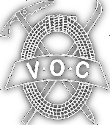









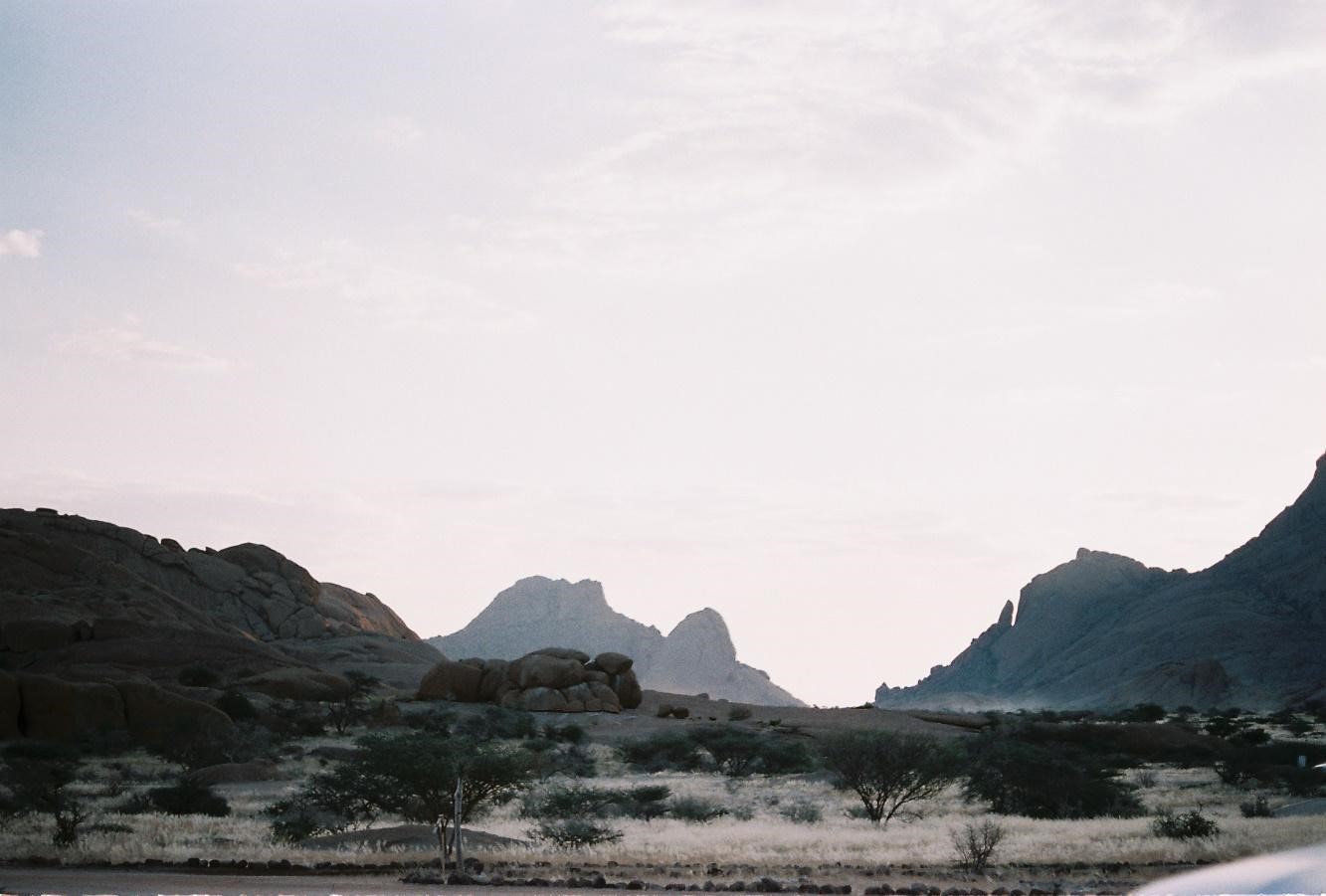
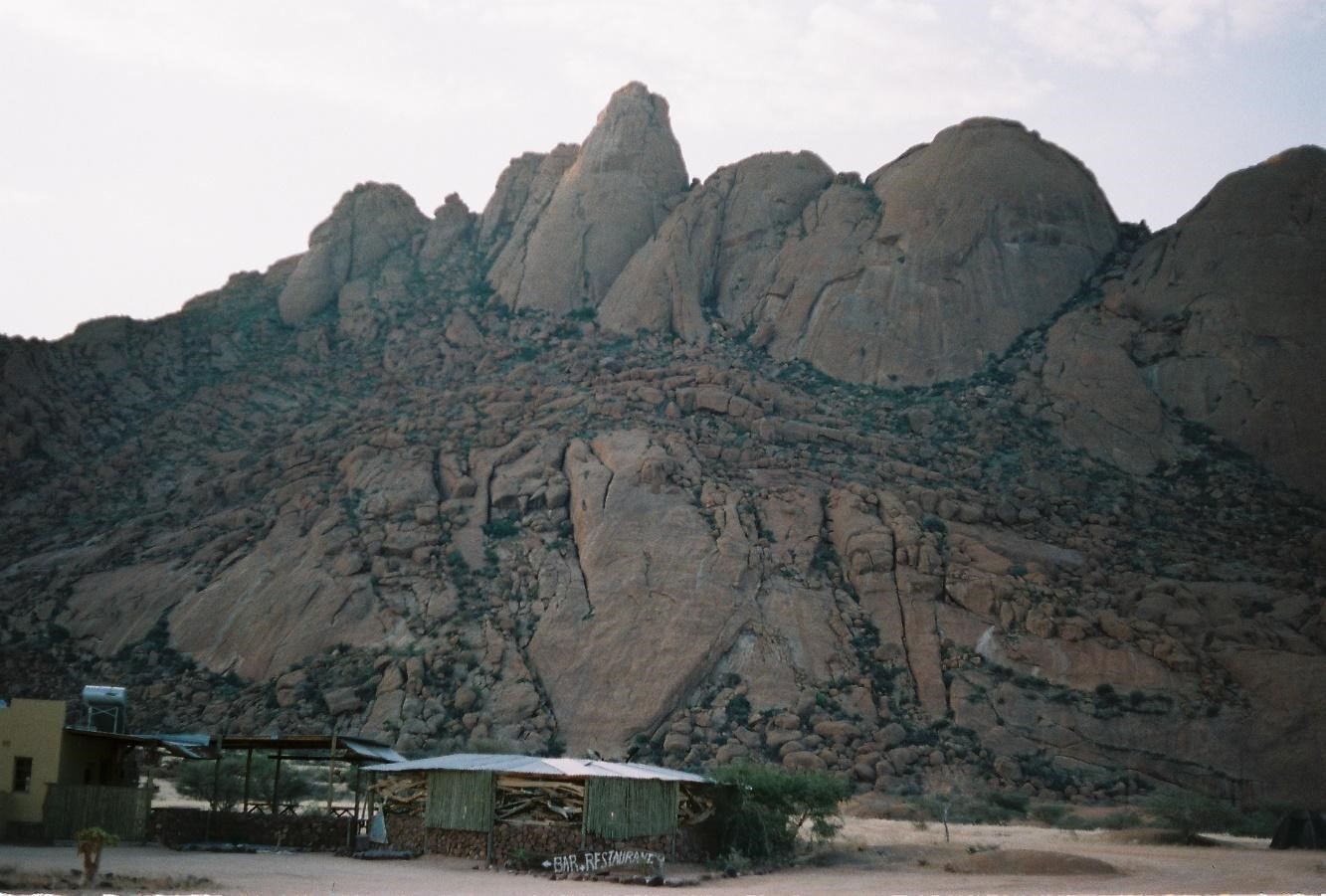

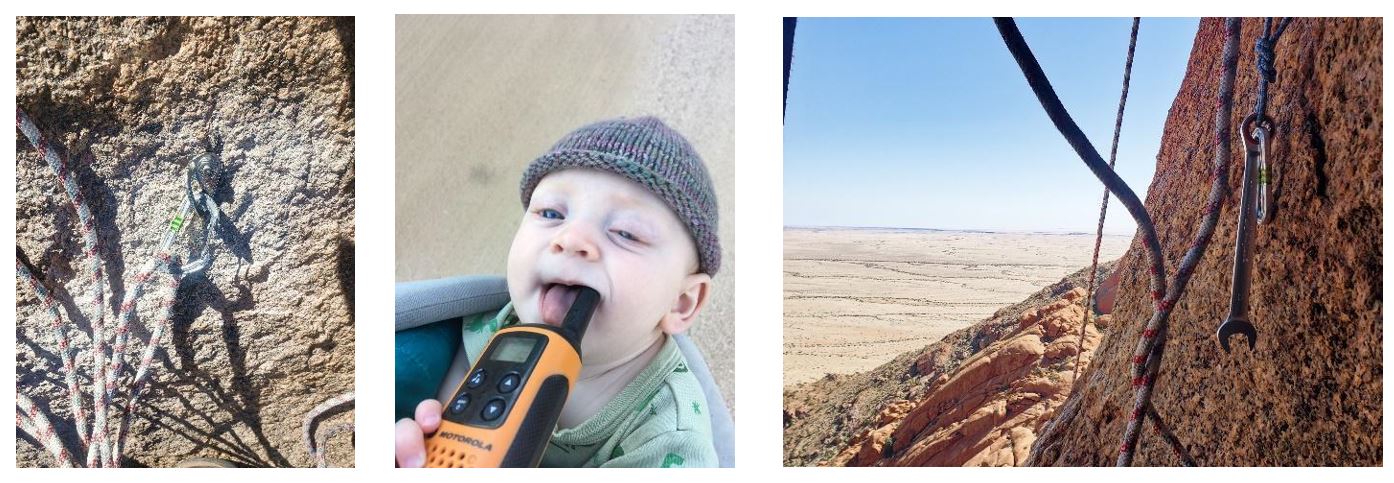

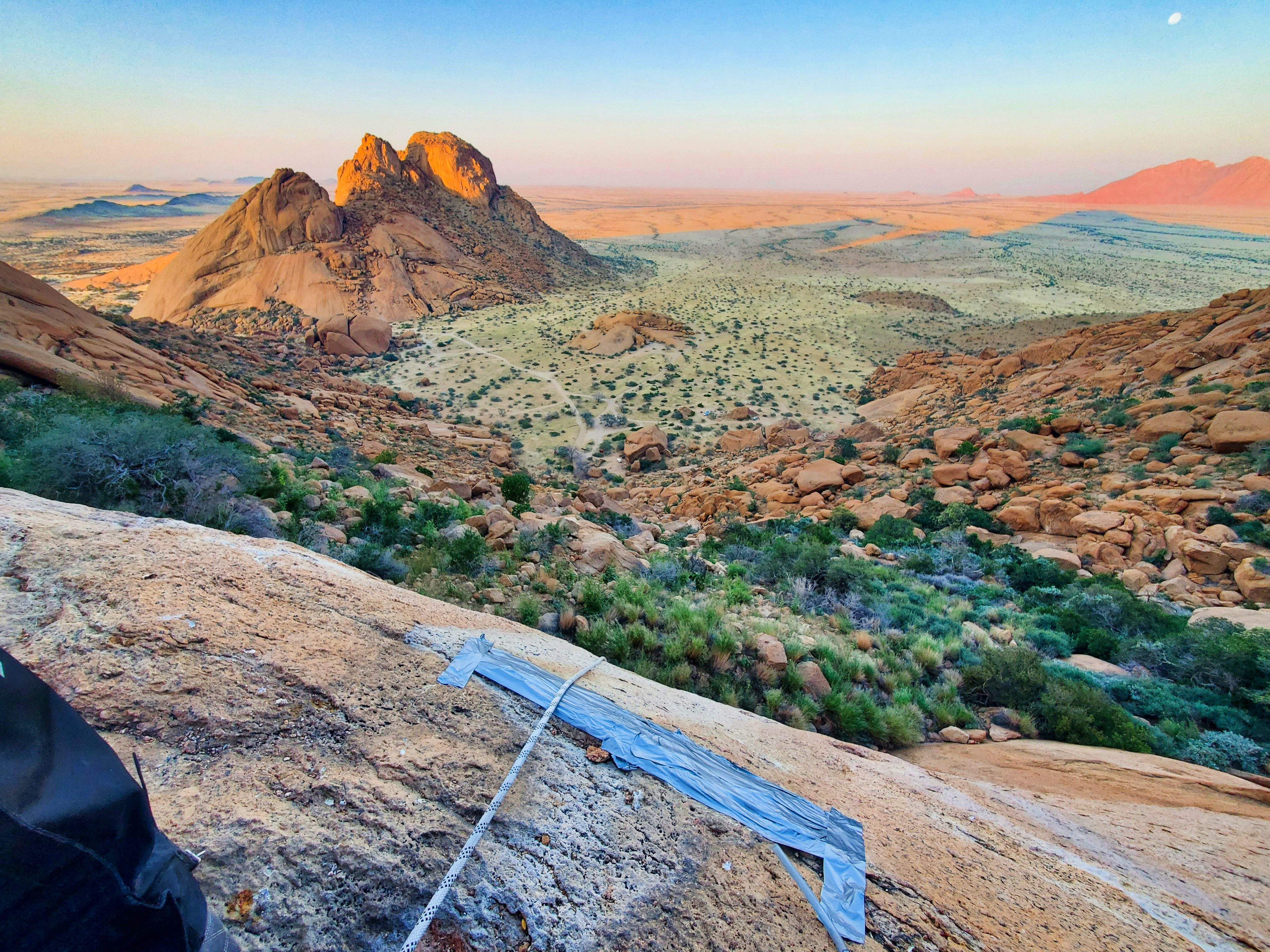




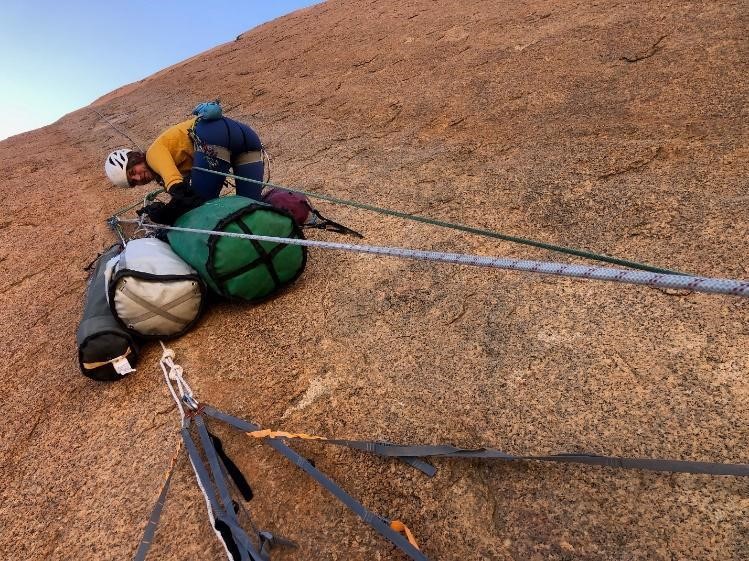
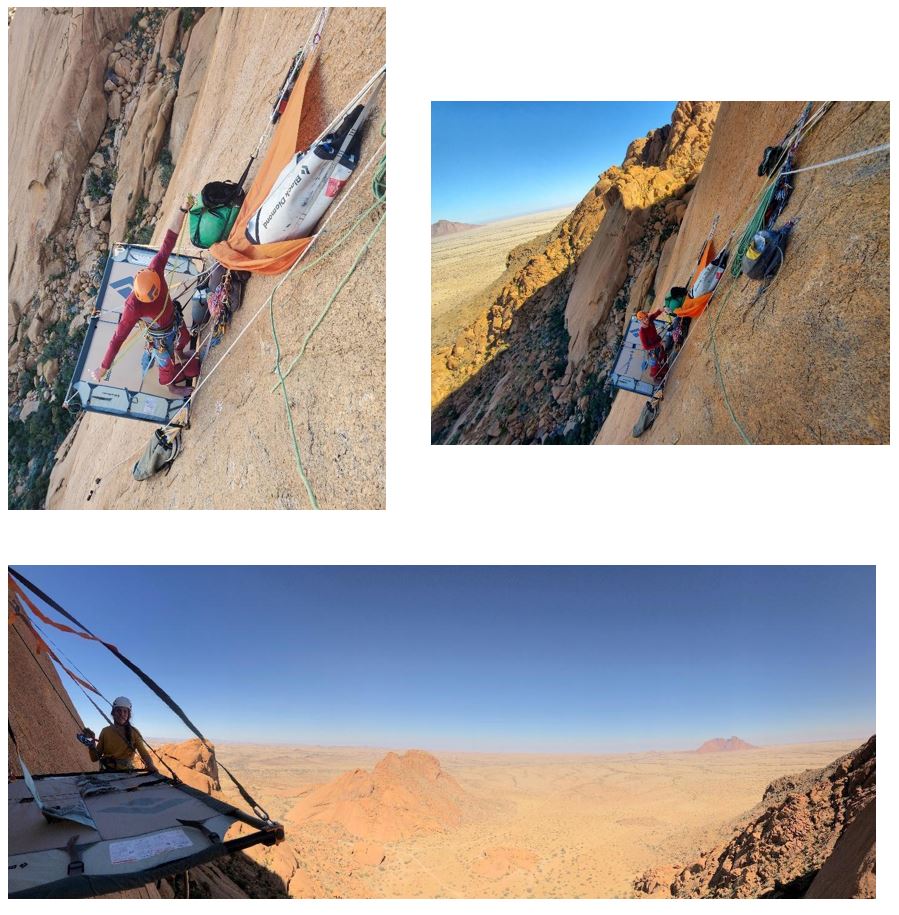

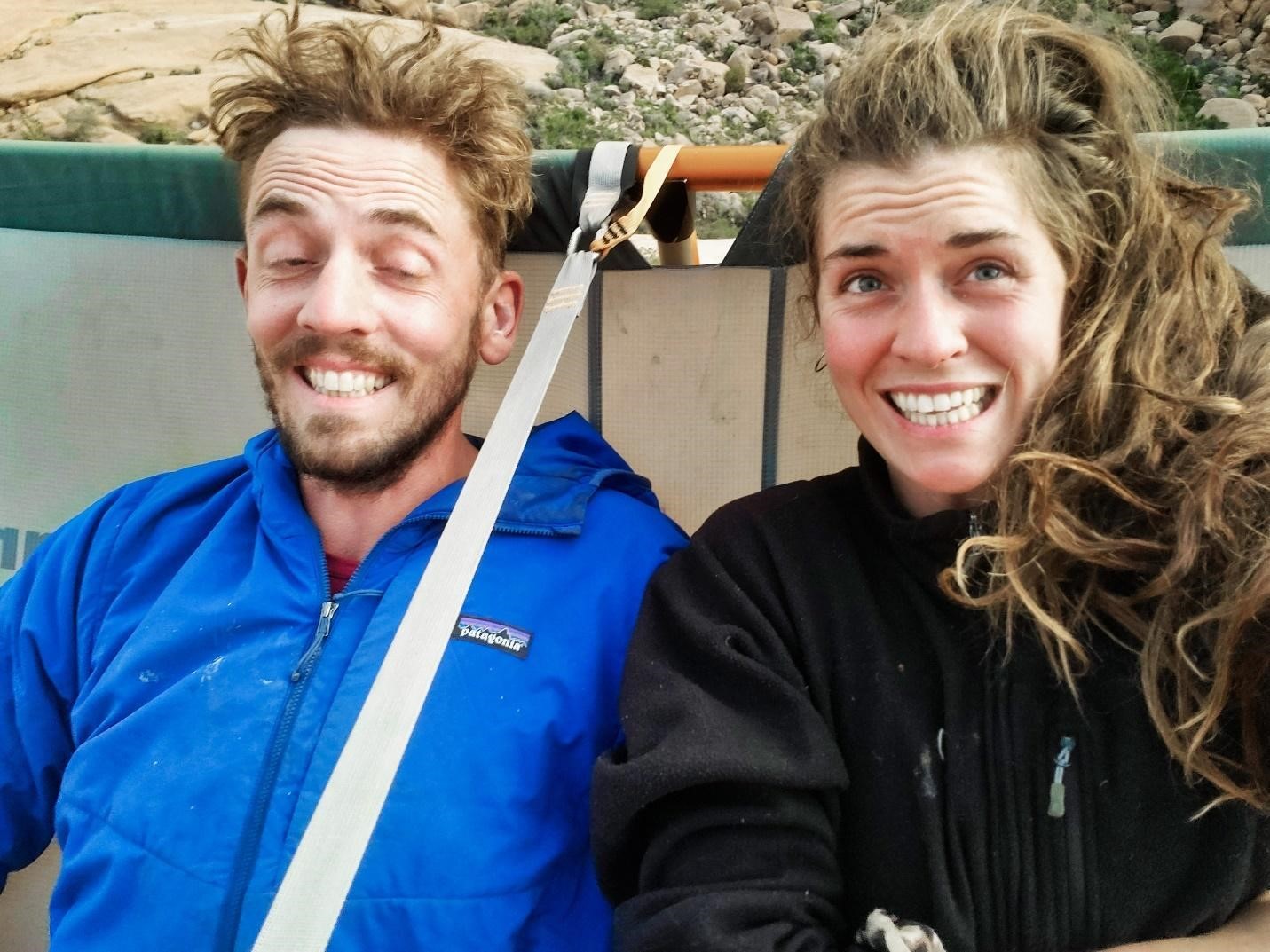

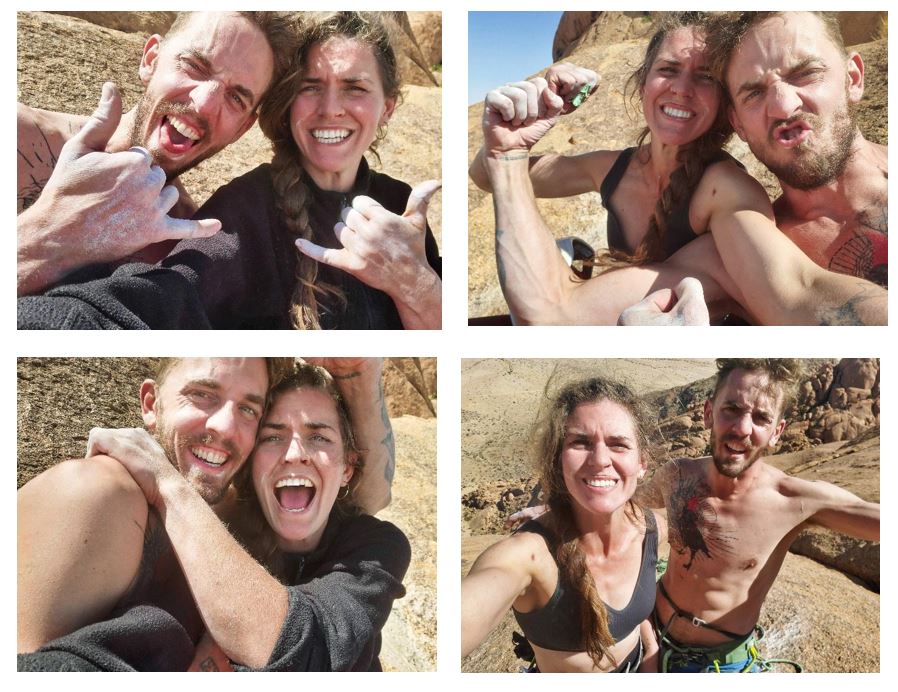
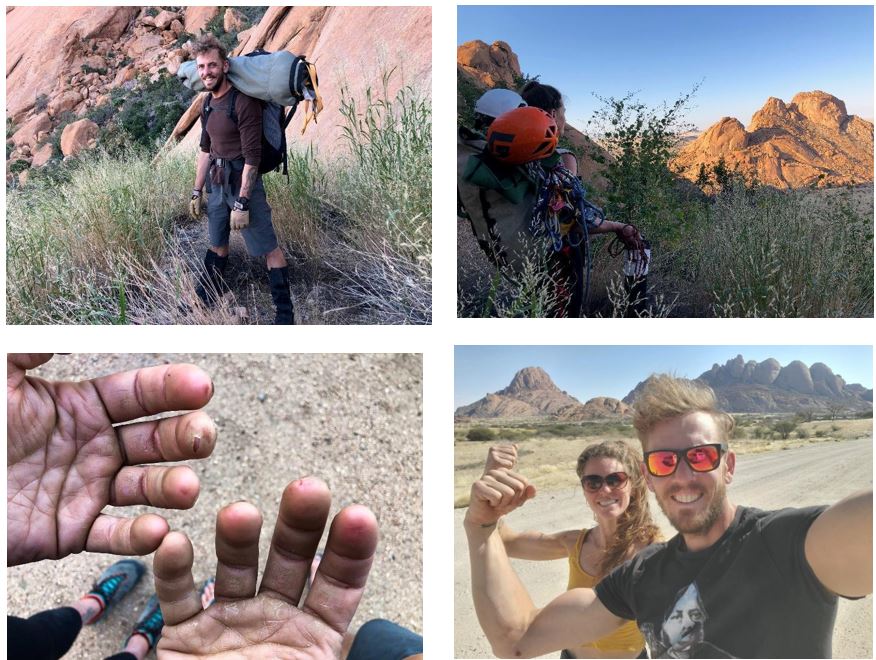
Thanks for opening up and sharing this. I think people respond to trip reports about people they’re buddies with doing the same stuff they do much more naturally than they do to something that’s way outside what they normally do. I’ve revisited this report four times now, and I imagine that a lot of others have as well, but don’t know how to quite approach leaving a comment. It’s touching and inspiring.
Very late to comment, but if you ever read this you did an amazing job on this route and trip report. So much effort was put into both and it shows. Sounds like the trip of a lifetime!